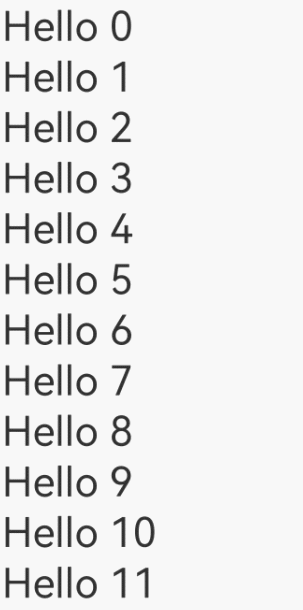LazyForEach: Lazy Data Loading
LazyForEach iterates over provided data sources and creates corresponding components during each iteration. When LazyForEach is used in a scrolling container, the framework creates components as required within the visible area of the scrolling container. When a component is out of the visible area, the framework destroys and reclaims the component to reduce memory usage.
API Description
LazyForEach(
dataSource: IDataSource, // Data source to iterate over.
itemGenerator: (item: any, index?: number) => void, // Child component generation function.
keyGenerator?: (item: any, index?: number) => string // Key generation function.
): void
Parameters
| Name | Type | Mandatory | Description |
|---|---|---|---|
| dataSource | IDataSource | Yes | LazyForEach data source. You need to implement related APIs. |
| itemGenerator | (item: any, index?:number) => void | Yes | Child component generation function, which generates a child component for each data item in the array. NOTE item indicates the current data item, and index indicates the index of the data item. The function body of itemGenerator must be included in braces {...}. itemGenerator can and must generate only one child component for each iteration. The if statement is allowed in itemGenerator, but you must ensure that each branch of the if statement creates a child component of the same type. ForEach and LazyForEach statements are not allowed in itemGenerator. |
| keyGenerator | (item: any, index?:number) => string | No | ID generation function, which generates a unique and fixed ID for each data item in the data source. This ID must remain unchanged for the data item even when the item is relocated in the array. When the item is replaced by a new item, the ID of the new item must be different from that of the replaced item. This ID generation function is optional. However, for performance reasons, it is strongly recommended that the ID generation function be provided, so that the framework can better identify array changes. For example, if no ID generation function is provided, a reverse of an array will result in rebuilding of all nodes in LazyForEach. NOTE item indicates the current data item, and index indicates the index of the data item. The ID generated for each data item in the data source must be unique. |
IDataSource
interface IDataSource {
totalCount(): number; // Obtain the total number of data items.
getData(index: number): Object; // Obtain the data item that matches the specified index.
registerDataChangeListener(listener: DataChangeListener): void; // Register a data change listener.
unregisterDataChangeListener(listener: DataChangeListener): void; // Deregister the data change listener.
}
| Declaration | Parameter Type | Description |
|---|---|---|
| totalCount(): number | - | Obtains the total number of data items. |
| getData(index: number): any | number | Obtains the data item that matches the specified index. index: index of the data item to obtain. |
| registerDataChangeListener(listener:DataChangeListener): void | DataChangeListener | Registers a listener for data changes. listener: listener for data changes. |
| unregisterDataChangeListener(listener:DataChangeListener): void | DataChangeListener | Deregisters the listener for data changes. listener: listener for data changes. |
DataChangeListener
interface DataChangeListener {
onDataReloaded(): void; // Invoked after data is reloaded.
onDataAdded(index: number): void; // Invoked after data is added.
onDataMoved(from: number, to: number): void; // Invoked after data is moved.
onDataDeleted(index: number): void; // Invoked after data is deleted.
onDataChanged(index: number): void; // Invoked after data is changed.
onDataAdd(index: number): void; // Invoked after data is added.
onDataMove(from: number, to: number): void; // Invoked after data is moved.
onDataDelete(index: number): void; // Invoked after data is deleted.
onDataChange(index: number): void; // Invoked after data is changed.
}
| Declaration | Parameter Type | Description |
|---|---|---|
| onDataReloaded(): void | - | Invoked when all data is reloaded. For data items whose key remains unchanged, the original child component is used. For data items whose key changes, a new child component is created. |
| onDataAdd(index: number): void8+ | number | Invoked when data is added to the position indicated by the specified index. index: index of the position where data is added. |
| onDataMove(from: number, to: number): void8+ | from: number, to: number |
Invoked when data is moved. from: original position of data; to: target position of data. Data is swapped between the from and to positions. NOTE The ID must remain unchanged before and after data movement. If the ID changes, APIs for deleting and adding data must be called. |
| onDataDelete(index: number):void8+ | number | Invoked when data is deleted from the position indicated by the specified index. LazyForEach will update the displayed content accordingly. index: index of the position where data is deleted. NOTE Before onDataDelete is called, ensure that the corresponding data in dataSource has been deleted. Otherwise, undefined behavior will occur during page rendering. |
| onDataChange(index: number): void8+ | number | Invoked when data in the position indicated by the specified index is changed. index: index of the position where data is changed. |
| onDataAdded(index: number):void(deprecated) | number | Invoked when data is added to the position indicated by the specified index. This API is deprecated since API version 8. You are advised to use onDataAdd instead. index: index of the position where data is added. |
| onDataMoved(from: number, to: number): void(deprecated) | from: number, to: number |
Invoked when data is moved. This API is deprecated since API version 8. You are advised to use onDataMove instead. from: original position of data; to: target position of data. NOTE The ID must remain unchanged before and after data movement. If the ID changes, APIs for deleting and adding data must be called. |
| onDataDeleted(index: number):void(deprecated) | number | Invoked when data is deleted from the position indicated by the specified index. LazyForEach will update the displayed content accordingly. This API is deprecated since API version 8. You are advised to use onDataDelete instead. index: index of the position where data is deleted. |
| onDataChanged(index: number): void(deprecated) | number | Invoked when data in the position indicated by the specified index is changed. This API is deprecated since API version 8. You are advised to use onDataChange instead. index: listener for data changes. |
Constraints
- LazyForEach must be used in a container component. Only the <List>, <Grid>, <Swiper>, and <WaterFlow> components support lazy loading (that is, only the visible part and a small amount of data before and after the visible part are loaded for caching). For other components, all data is loaded at once.
- LazyForEach must create one and only one child component in each iteration.
- The generated child components must be allowed in the parent container component of LazyForEach.
- LazyForEach can be included in an if/else statement, and can also contain such a statement.
- The ID generation function must generate a unique value for each piece of data. If the IDs are the same, the framework ignores the UI components with the same key value. As a result, these UI components cannot be displayed in the parent container.
- LazyForEach must be updated using a DataChangeListener object. When the first parameter dataSource uses a state variable, a state variable change does not trigger the UI update of LazyForEach.
- For better rendering performance, when the onDataChange API of the DataChangeListener object is used to update the UI, an ID different from the original one needs to be generated to trigger component re-rendering.
Key Generation Rules
During LazyForEach rendering, the system generates a unique, persistent key for each item to identify the owing component. When the key changes, the ArkUI framework considers that the array element has been replaced or modified and creates a new component based on the new key.
LazyForEach provides a parameter named keyGenerator, which is in effect a function through which you can customize key generation rules. If no keyGenerator function is defined, the ArkUI framework uses the default key generation function, that is, (item: any, index: number) => { return viewId + '-' + index.toString(); }, wherein viewId is generated during compiler conversion. The viewId values in the same LazyForEach component are the same.
Component Creation Rules
After the key generation rules are determined, the itemGenerator function – the second parameter in LazyForEach – creates a component for each array item of the data source based on the rules. There are two cases for creating a component: initial render and non initial render.
Initial Render
-
Generating Different Key Values
When used for initial render, LazyForEach generates a unique key for each array item of the data source based on the key generation rules, and creates a component.
// Basic implementation of IDataSource to handle data listener
class BasicDataSource implements IDataSource {
private listeners: DataChangeListener[] = [];
private originDataArray: string[] = [];
public totalCount(): number {
return 0;
}
public getData(index: number): string {
return this.originDataArray[index];
}
// This method is called by the framework to add a listener to the LazyForEach data source.
registerDataChangeListener(listener: DataChangeListener): void {
if (this.listeners.indexOf(listener) < 0) {
console.info('add listener');
this.listeners.push(listener);
}
}
// This method is called by the framework to remove the listener from the LazyForEach data source.
unregisterDataChangeListener(listener: DataChangeListener): void {
const pos = this.listeners.indexOf(listener);
if (pos >= 0) {
console.info('remove listener');
this.listeners.splice(pos, 1);
}
}
// Notify LazyForEach that all child components need to be reloaded.
notifyDataReload(): void {
this.listeners.forEach(listener => {
listener.onDataReloaded();
})
}
// Notify LazyForEach that a child component needs to be added for the data item with the specified index.
notifyDataAdd(index: number): void {
this.listeners.forEach(listener => {
listener.onDataAdd(index);
})
}
// Notify LazyForEach that the data item with the specified index has changed and the child component needs to be rebuilt.
notifyDataChange(index: number): void {
this.listeners.forEach(listener => {
listener.onDataChange(index);
})
}
// Notify LazyForEach that the child component that matches the specified index needs to be deleted.
notifyDataDelete(index: number): void {
this.listeners.forEach(listener => {
listener.onDataDelete(index);
})
}
}
class MyDataSource extends BasicDataSource {
private dataArray: string[] = [];
public totalCount(): number {
return this.dataArray.length;
}
public getData(index: number): string {
return this.dataArray[index];
}
public addData(index: number, data: string): void {
this.dataArray.splice(index, 0, data);
this.notifyDataAdd(index);
}
public pushData(data: string): void {
this.dataArray.push(data);
this.notifyDataAdd(this.dataArray.length - 1);
}
}
@Entry
@Component
struct MyComponent {
private data: MyDataSource = new MyDataSource();
aboutToAppear() {
for (let i = 0; i <= 20; i++) {
this.data.pushData(`Hello ${i}`)
}
}
build() {
List({ space: 3 }) {
LazyForEach(this.data, (item: string) => {
ListItem() {
Row() {
Text(item).fontSize(50)
.onAppear(() => {
console.info("appear:" + item)
})
}.margin({ left: 10, right: 10 })
}
}, (item: string) => item)
}.cachedCount(5)
}
}
In the preceding code snippets, the key generation rule is the return value item of the keyGenerator function. During LazyForEach rendering, keys (from Hello 0, Hello 1, through to Hello 20) are generated in sequence for data source array items, and corresponding list items are created and rendered to the UI.
The figure below shows the effect.
Figure 1 Initial render of LazyForEach
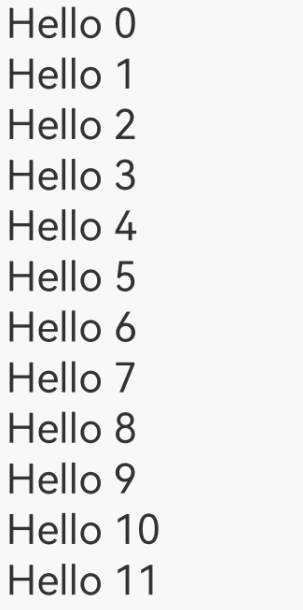
-
Incorrect Rendering When Keys Are the Same
When the keys generated for different data items are the same, the behavior of the framework is unpredictable. For example, in the following code, the keys of the data items rendered by LazyForEach are the same. During the swipe process, LazyForEach preloads child components for the current page. Because the new child component and the destroyed component have the same key, the framework may incorrectly obtain the cache. As a result, the child component rendering is abnormal.
class BasicDataSource implements IDataSource {
private listeners: DataChangeListener[] = [];
private originDataArray: string[] = [];
public totalCount(): number {
return 0;
}
public getData(index: number): string {
return this.originDataArray[index];
}
registerDataChangeListener(listener: DataChangeListener): void {
if (this.listeners.indexOf(listener) < 0) {
console.info('add listener');
this.listeners.push(listener);
}
}
unregisterDataChangeListener(listener: DataChangeListener): void {
const pos = this.listeners.indexOf(listener);
if (pos >= 0) {
console.info('remove listener');
this.listeners.splice(pos, 1);
}
}
notifyDataReload(): void {
this.listeners.forEach(listener => {
listener.onDataReloaded();
})
}
notifyDataAdd(index: number): void {
this.listeners.forEach(listener => {
listener.onDataAdd(index);
})
}
notifyDataChange(index: number): void {
this.listeners.forEach(listener => {
listener.onDataChange(index);
})
}
notifyDataDelete(index: number): void {
this.listeners.forEach(listener => {
listener.onDataDelete(index);
})
}
}
class MyDataSource extends BasicDataSource {
private dataArray: string[] = [];
public totalCount(): number {
return this.dataArray.length;
}
public getData(index: number): string {
return this.dataArray[index];
}
public addData(index: number, data: string): void {
this.dataArray.splice(index, 0, data);
this.notifyDataAdd(index);
}
public pushData(data: string): void {
this.dataArray.push(data);
this.notifyDataAdd(this.dataArray.length - 1);
}
}
@Entry
@Component
struct MyComponent {
private data: MyDataSource = new MyDataSource();
aboutToAppear() {
for (let i = 0; i <= 20; i++) {
this.data.pushData(`Hello ${i}`)
}
}
build() {
List({ space: 3 }) {
LazyForEach(this.data, (item: string) => {
ListItem() {
Row() {
Text(item).fontSize(50)
.onAppear(() => {
console.info("appear:" + item)
})
}.margin({ left: 10, right: 10 })
}
}, (item: string) => 'same key')
}.cachedCount(5)
}
}
The figure below shows the effect. You can see that Hello 0 is incorrectly rendered as Hello 13 during the swiping.
Figure 2 LazyForEach rendering when keys are the same
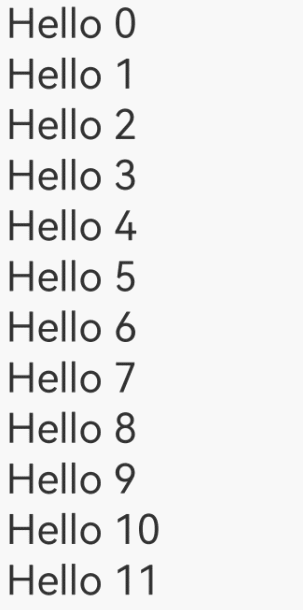
Non Initial Render
When the LazyForEach data source changes and a re-render is required, call a listener API based on the data source change to notify LazyForEach. Below are some use cases.
-
Adding Data
class BasicDataSource implements IDataSource {
private listeners: DataChangeListener[] = [];
private originDataArray: string[] = [];
public totalCount(): number {
return 0;
}
public getData(index: number): string {
return this.originDataArray[index];
}
registerDataChangeListener(listener: DataChangeListener): void {
if (this.listeners.indexOf(listener) < 0) {
console.info('add listener');
this.listeners.push(listener);
}
}
unregisterDataChangeListener(listener: DataChangeListener): void {
const pos = this.listeners.indexOf(listener);
if (pos >= 0) {
console.info('remove listener');
this.listeners.splice(pos, 1);
}
}
notifyDataReload(): void {
this.listeners.forEach(listener => {
listener.onDataReloaded();
})
}
notifyDataAdd(index: number): void {
this.listeners.forEach(listener => {
listener.onDataAdd(index);
})
}
notifyDataChange(index: number): void {
this.listeners.forEach(listener => {
listener.onDataChange(index);
})
}
notifyDataDelete(index: number): void {
this.listeners.forEach(listener => {
listener.onDataDelete(index);
})
}
}
class MyDataSource extends BasicDataSource {
private dataArray: string[] = [];
public totalCount(): number {
return this.dataArray.length;
}
public getData(index: number): string {
return this.dataArray[index];
}
public addData(index: number, data: string): void {
this.dataArray.splice(index, 0, data);
this.notifyDataAdd(index);
}
public pushData(data: string): void {
this.dataArray.push(data);
this.notifyDataAdd(this.dataArray.length - 1);
}
}
@Entry
@Component
struct MyComponent {
private data: MyDataSource = new MyDataSource();
aboutToAppear() {
for (let i = 0; i <= 20; i++) {
this.data.pushData(`Hello ${i}`)
}
}
build() {
List({ space: 3 }) {
LazyForEach(this.data, (item: string) => {
ListItem() {
Row() {
Text(item).fontSize(50)
.onAppear(() => {
console.info("appear:" + item)
})
}.margin({ left: 10, right: 10 })
}
.onClick(() => {
// Click to add a child component.
this.data.pushData(`Hello ${this.data.totalCount()}`);
})
}, (item: string) => item)
}.cachedCount(5)
}
}
When the child component of LazyForEach is clicked, the pushData method of the data source is called first. This method adds data to the end of the data source and then calls the notifyDataAdd method. In the notifyDataAdd method, the listener.onDataAdd method is called to notify LazyForEach that data is added, and LazyForEach creates a child component at the position indicated by the specified index.
The figure below shows the effect.
Figure 3 Adding data to LazyForEach
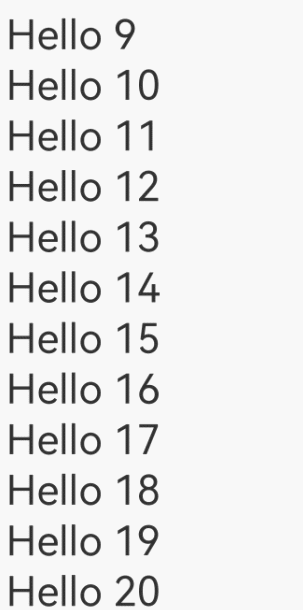
-
Deleting Data
class BasicDataSource implements IDataSource {
private listeners: DataChangeListener[] = [];
private originDataArray: string[] = [];
public totalCount(): number {
return 0;
}
public getData(index: number): string {
return this.originDataArray[index];
}
registerDataChangeListener(listener: DataChangeListener): void {
if (this.listeners.indexOf(listener) < 0) {
console.info('add listener');
this.listeners.push(listener);
}
}
unregisterDataChangeListener(listener: DataChangeListener): void {
const pos = this.listeners.indexOf(listener);
if (pos >= 0) {
console.info('remove listener');
this.listeners.splice(pos, 1);
}
}
notifyDataReload(): void {
this.listeners.forEach(listener => {
listener.onDataReloaded();
})
}
notifyDataAdd(index: number): void {
this.listeners.forEach(listener => {
listener.onDataAdd(index);
})
}
notifyDataChange(index: number): void {
this.listeners.forEach(listener => {
listener.onDataChange(index);
})
}
notifyDataDelete(index: number): void {
this.listeners.forEach(listener => {
listener.onDataDelete(index);
})
}
}
class MyDataSource extends BasicDataSource {
dataArray: string[] = [];
public totalCount(): number {
return this.dataArray.length;
}
public getData(index: number): string {
return this.dataArray[index];
}
public addData(index: number, data: string): void {
this.dataArray.splice(index, 0, data);
this.notifyDataAdd(index);
}
public pushData(data: string): void {
this.dataArray.push(data);
this.notifyDataAdd(this.dataArray.length - 1);
}
public deleteData(index: number): void {
this.dataArray.splice(index, 1);
this.notifyDataDelete(index);
}
}
@Entry
@Component
struct MyComponent {
private data: MyDataSource = new MyDataSource();
aboutToAppear() {
for (let i = 0; i <= 20; i++) {
this.data.pushData(`Hello ${i}`)
}
}
build() {
List({ space: 3 }) {
LazyForEach(this.data, (item: string, index: number) => {
ListItem() {
Row() {
Text(item).fontSize(50)
.onAppear(() => {
console.info("appear:" + item)
})
}.margin({ left: 10, right: 10 })
}
.onClick(() => {
// Click to delete a child component.
this.data.deleteData(this.data.dataArray.indexOf(item));
})
}, (item: string) => item)
}.cachedCount(5)
}
}
When the child component of LazyForEach is clicked, the deleteData method of the data source is called first. This method deletes data that matches the specified index from the data source and then calls the notifyDataDelete method. In the notifyDataDelete method, the listener.onDataDelete method is called to notify LazyForEach that data is deleted, and LazyForEach deletes the child component at the position indicated by the specified index.
The figure below shows the effect.
Figure 4 Deleting data from LazyForEach
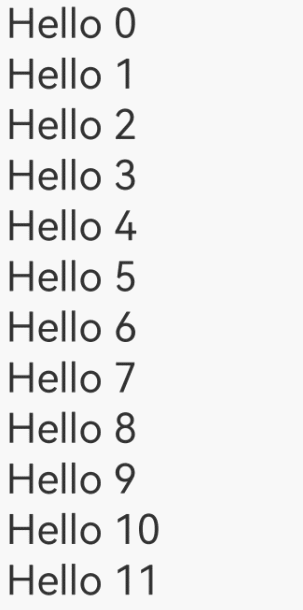
-
Changing a Data Item
class BasicDataSource implements IDataSource {
private listeners: DataChangeListener[] = [];
private originDataArray: string[] = [];
public totalCount(): number {
return 0;
}
public getData(index: number): string {
return this.originDataArray[index];
}
registerDataChangeListener(listener: DataChangeListener): void {
if (this.listeners.indexOf(listener) < 0) {
console.info('add listener');
this.listeners.push(listener);
}
}
unregisterDataChangeListener(listener: DataChangeListener): void {
const pos = this.listeners.indexOf(listener);
if (pos >= 0) {
console.info('remove listener');
this.listeners.splice(pos, 1);
}
}
notifyDataReload(): void {
this.listeners.forEach(listener => {
listener.onDataReloaded();
})
}
notifyDataAdd(index: number): void {
this.listeners.forEach(listener => {
listener.onDataAdd(index);
})
}
notifyDataChange(index: number): void {
this.listeners.forEach(listener => {
listener.onDataChange(index);
})
}
notifyDataDelete(index: number): void {
this.listeners.forEach(listener => {
listener.onDataDelete(index);
})
}
}
class MyDataSource extends BasicDataSource {
private dataArray: string[] = [];
public totalCount(): number {
return this.dataArray.length;
}
public getData(index: number): string {
return this.dataArray[index];
}
public addData(index: number, data: string): void {
this.dataArray.splice(index, 0, data);
this.notifyDataAdd(index);
}
public pushData(data: string): void {
this.dataArray.push(data);
this.notifyDataAdd(this.dataArray.length - 1);
}
public deleteData(index: number): void {
this.dataArray.splice(index, 1);
this.notifyDataDelete(index);
}
public changeData(index: number, data: string): void {
this.dataArray.splice(index, 1, data);
this.notifyDataChange(index);
}
}
@Entry
@Component
struct MyComponent {
private moved: number[] = [];
private data: MyDataSource = new MyDataSource();
aboutToAppear() {
for (let i = 0; i <= 20; i++) {
this.data.pushData(`Hello ${i}`)
}
}
build() {
List({ space: 3 }) {
LazyForEach(this.data, (item: string, index: number) => {
ListItem() {
Row() {
Text(item).fontSize(50)
.onAppear(() => {
console.info("appear:" + item)
})
}.margin({ left: 10, right: 10 })
}
.onClick(() => {
this.data.changeData(index, item + '00');
})
}, (item: string) => item)
}.cachedCount(5)
}
}
When the child component of LazyForEach is clicked, the data is changed first, and then the changeData method of the data source is called. In this method, the notifyDataChange method is called. In the notifyDataChange method, the listener.onDataChange method is called to notify LazyForEach of data changes. LazyForEach then rebuilds the child component that matches the specified index.
The figure below shows the effect.
Figure 5 Changing a data item in LazyForEach
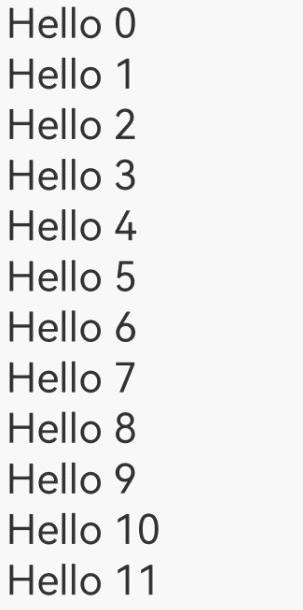
-
Changing Multiple Data Items
class BasicDataSource implements IDataSource {
private listeners: DataChangeListener[] = [];
private originDataArray: string[] = [];
public totalCount(): number {
return 0;
}
public getData(index: number): string {
return this.originDataArray[index];
}
registerDataChangeListener(listener: DataChangeListener): void {
if (this.listeners.indexOf(listener) < 0) {
console.info('add listener');
this.listeners.push(listener);
}
}
unregisterDataChangeListener(listener: DataChangeListener): void {
const pos = this.listeners.indexOf(listener);
if (pos >= 0) {
console.info('remove listener');
this.listeners.splice(pos, 1);
}
}
notifyDataReload(): void {
this.listeners.forEach(listener => {
listener.onDataReloaded();
})
}
notifyDataAdd(index: number): void {
this.listeners.forEach(listener => {
listener.onDataAdd(index);
})
}
notifyDataChange(index: number): void {
this.listeners.forEach(listener => {
listener.onDataChange(index);
})
}
notifyDataDelete(index: number): void {
this.listeners.forEach(listener => {
listener.onDataDelete(index);
})
}
}
class MyDataSource extends BasicDataSource {
private dataArray: string[] = [];
public totalCount(): number {
return this.dataArray.length;
}
public getData(index: number): string {
return this.dataArray[index];
}
public addData(index: number, data: string): void {
this.dataArray.splice(index, 0, data);
this.notifyDataAdd(index);
}
public pushData(data: string): void {
this.dataArray.push(data);
this.notifyDataAdd(this.dataArray.length - 1);
}
public deleteData(index: number): void {
this.dataArray.splice(index, 1);
this.notifyDataDelete(index);
}
public changeData(index: number): void {
this.notifyDataChange(index);
}
public reloadData(): void {
this.notifyDataReload();
}
public modifyAllData(): void {
this.dataArray = this.dataArray.map((item: string) => {
return item + '0';
})
}
}
@Entry
@Component
struct MyComponent {
private moved: number[] = [];
private data: MyDataSource = new MyDataSource();
aboutToAppear() {
for (let i = 0; i <= 20; i++) {
this.data.pushData(`Hello ${i}`)
}
}
build() {
List({ space: 3 }) {
LazyForEach(this.data, (item: string, index: number) => {
ListItem() {
Row() {
Text(item).fontSize(50)
.onAppear(() => {
console.info("appear:" + item)
})
}.margin({ left: 10, right: 10 })
}
.onClick(() => {
this.data.modifyAllData();
this.data.reloadData();
})
}, (item: string) => item)
}.cachedCount(5)
}
}
When a child component of LazyForEach is clicked, the modifyAllData method of the data source is called to change all data items, and then the reloadData method of the data source is called. In this method, the notifyDataReload method is called. In the notifyDataReload method, the listener.onDataReloaded method is called to notify LazyForEach that all subnodes need to be rebuilt. LazyForEach compares the keys of all original data items with those of all new data items on a one-by-one basis. If the keys are the same, the cache is used. If the keys are different, the child component is rebuilt.
The figure below shows the effect.
Figure 6 Changing multiple data items in LazyForEach
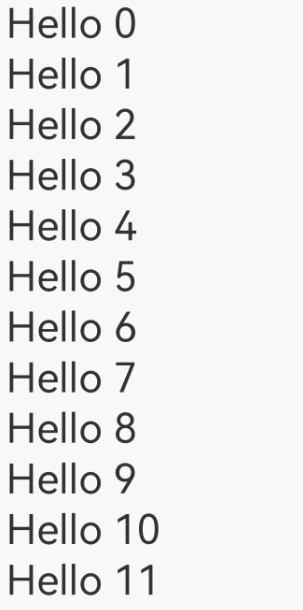
-
Changing Data Subproperties
When LazyForEach is used for UI re-renders, a child component needs to be destroyed and rebuilt when the data item changes. This may result in low re-render performance when the child component structure is complex. This is where @Observed and @ObjectLink come into picture. By providing in-depth observation, @Observed and @ObjectLink enable precise re-renders of only components that use the changed properties. You can select a re-render mode that better suits your needs.
class BasicDataSource implements IDataSource {
private listeners: DataChangeListener[] = [];
private originDataArray: StringData[] = [];
public totalCount(): number {
return 0;
}
public getData(index: number): StringData {
return this.originDataArray[index];
}
registerDataChangeListener(listener: DataChangeListener): void {
if (this.listeners.indexOf(listener) < 0) {
console.info('add listener');
this.listeners.push(listener);
}
}
unregisterDataChangeListener(listener: DataChangeListener): void {
const pos = this.listeners.indexOf(listener);
if (pos >= 0) {
console.info('remove listener');
this.listeners.splice(pos, 1);
}
}
notifyDataReload(): void {
this.listeners.forEach(listener => {
listener.onDataReloaded();
})
}
notifyDataAdd(index: number): void {
this.listeners.forEach(listener => {
listener.onDataAdd(index);
})
}
notifyDataChange(index: number): void {
this.listeners.forEach(listener => {
listener.onDataChange(index);
})
}
notifyDataDelete(index: number): void {
this.listeners.forEach(listener => {
listener.onDataDelete(index);
})
}
}
class MyDataSource extends BasicDataSource {
private dataArray: StringData[] = [];
public totalCount(): number {
return this.dataArray.length;
}
public getData(index: number): StringData {
return this.dataArray[index];
}
public addData(index: number, data: StringData): void {
this.dataArray.splice(index, 0, data);
this.notifyDataAdd(index);
}
public pushData(data: StringData): void {
this.dataArray.push(data);
this.notifyDataAdd(this.dataArray.length - 1);
}
}
@Observed
class StringData {
message: string;
constructor(message: string) {
this.message = message;
}
}
@Entry
@Component
struct MyComponent {
private moved: number[] = [];
@State data: MyDataSource = new MyDataSource();
aboutToAppear() {
for (let i = 0; i <= 20; i++) {
this.data.pushData(new StringData(`Hello ${i}`));
}
}
build() {
List({ space: 3 }) {
LazyForEach(this.data, (item: StringData, index: number) => {
ListItem() {
ChildComponent({data: item})
}
.onClick(() => {
item.message += '0';
})
}, (item: StringData, index: number) => index.toString())
}.cachedCount(5)
}
}
@Component
struct ChildComponent {
@ObjectLink data: StringData
build() {
Row() {
Text(this.data.message).fontSize(50)
.onAppear(() => {
console.info("appear:" + this.data.message)
})
}.margin({ left: 10, right: 10 })
}
}
When the child component of LazyForEach is clicked, item.message is changed. As re-rendering depends on the listening of the @ObjectLink decorated member variable of ChildComponent on its subproperties. In this case, the framework only re-renders Text(this.data.message) and does not rebuild the entire ListItem child component.
Figure 7 Changing data subproperties in LazyForEach
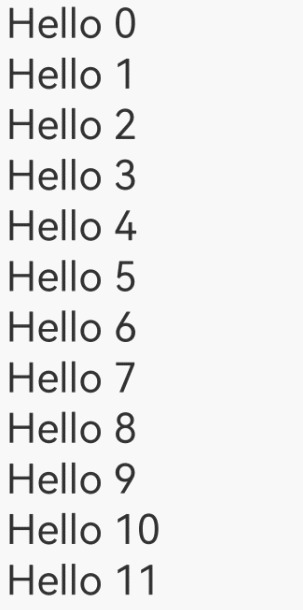
FAQs
-
Unexpected Rendering Result
class BasicDataSource implements IDataSource { private listeners: DataChangeListener[] = []; private originDataArray: string[] = []; public totalCount(): number { return 0; } public getData(index: number): string { return this.originDataArray[index]; } registerDataChangeListener(listener: DataChangeListener): void { if (this.listeners.indexOf(listener) < 0) { console.info('add listener'); this.listeners.push(listener); } } unregisterDataChangeListener(listener: DataChangeListener): void { const pos = this.listeners.indexOf(listener); if (pos >= 0) { console.info('remove listener'); this.listeners.splice(pos, 1); } } notifyDataReload(): void { this.listeners.forEach(listener => { listener.onDataReloaded(); }) } notifyDataAdd(index: number): void { this.listeners.forEach(listener => { listener.onDataAdd(index); }) } notifyDataChange(index: number): void { this.listeners.forEach(listener => { listener.onDataChange(index); }) } notifyDataDelete(index: number): void { this.listeners.forEach(listener => { listener.onDataDelete(index); }) } } class MyDataSource extends BasicDataSource { private dataArray: string[] = []; public totalCount(): number { return this.dataArray.length; } public getData(index: number): string { return this.dataArray[index]; } public addData(index: number, data: string): void { this.dataArray.splice(index, 0, data); this.notifyDataAdd(index); } public pushData(data: string): void { this.dataArray.push(data); this.notifyDataAdd(this.dataArray.length - 1); } public deleteData(index: number): void { this.dataArray.splice(index, 1); this.notifyDataDelete(index); } } @Entry @Component struct MyComponent { private data: MyDataSource = new MyDataSource(); aboutToAppear() { for (let i = 0; i <= 20; i++) { this.data.pushData(`Hello ${i}`) } } build() { List({ space: 3 }) { LazyForEach(this.data, (item: string, index: number) => { ListItem() { Row() { Text(item).fontSize(50) .onAppear(() => { console.info("appear:" + item) }) }.margin({ left: 10, right: 10 }) } .onClick(() => { // Click to delete a child component. this.data.deleteData(index); }) }, (item: string) => item) }.cachedCount(5) } }Figure 8 Unexpected data deletion by LazyForEach
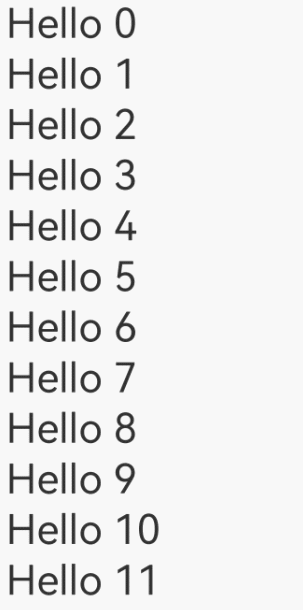
When child components are clicked to be deleted, there may be cases where the deleted child component is not the one clicked. If this is the case, the indexes of data items are not updated correctly. In normal cases, after a child component is deleted, all data items following the data item of the child component should have their index decreased by 1. If these data items still use the original indexes, the indexes in itemGenerator do not change, resulting in the unexpected rendering result.
The following shows the code snippet after optimization:
class BasicDataSource implements IDataSource { private listeners: DataChangeListener[] = []; private originDataArray: string[] = []; public totalCount(): number { return 0; } public getData(index: number): string { return this.originDataArray[index]; } registerDataChangeListener(listener: DataChangeListener): void { if (this.listeners.indexOf(listener) < 0) { console.info('add listener'); this.listeners.push(listener); } } unregisterDataChangeListener(listener: DataChangeListener): void { const pos = this.listeners.indexOf(listener); if (pos >= 0) { console.info('remove listener'); this.listeners.splice(pos, 1); } } notifyDataReload(): void { this.listeners.forEach(listener => { listener.onDataReloaded(); }) } notifyDataAdd(index: number): void { this.listeners.forEach(listener => { listener.onDataAdd(index); }) } notifyDataChange(index: number): void { this.listeners.forEach(listener => { listener.onDataChange(index); }) } notifyDataDelete(index: number): void { this.listeners.forEach(listener => { listener.onDataDelete(index); }) } } class MyDataSource extends BasicDataSource { private dataArray: string[] = []; public totalCount(): number { return this.dataArray.length; } public getData(index: number): string { return this.dataArray[index]; } public addData(index: number, data: string): void { this.dataArray.splice(index, 0, data); this.notifyDataAdd(index); } public pushData(data: string): void { this.dataArray.push(data); this.notifyDataAdd(this.dataArray.length - 1); } public deleteData(index: number): void { this.dataArray.splice(index, 1); this.notifyDataDelete(index); } public reloadData(): void { this.notifyDataReload(); } } @Entry @Component struct MyComponent { private data: MyDataSource = new MyDataSource(); aboutToAppear() { for (let i = 0; i <= 20; i++) { this.data.pushData(`Hello ${i}`) } } build() { List({ space: 3 }) { LazyForEach(this.data, (item: string, index: number) => { ListItem() { Row() { Text(item).fontSize(50) .onAppear(() => { console.info("appear:" + item) }) }.margin({ left: 10, right: 10 }) } .onClick(() => { // Click to delete a child component. this.data.deleteData(index); // Reset the indexes of all child components. this.data.reloadData(); }) }, (item: string, index: number) => item + index.toString()) }.cachedCount(5) } }After a data item is deleted, the reloadData method is called to rebuild the subsequent data items to update the indexes.
Figure 9 Fixing unexpected data deletion
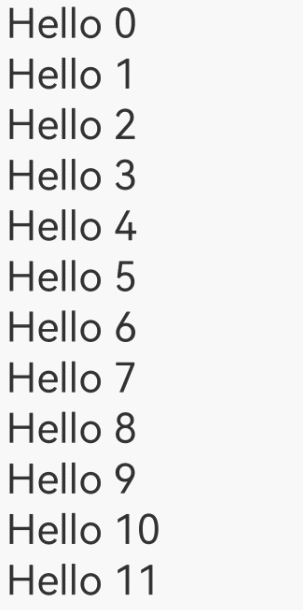
-
Image Flickering During Re-renders
class BasicDataSource implements IDataSource { private listeners: DataChangeListener[] = []; private originDataArray: StringData[] = []; public totalCount(): number { return 0; } public getData(index: number): StringData { return this.originDataArray[index]; } registerDataChangeListener(listener: DataChangeListener): void { if (this.listeners.indexOf(listener) < 0) { console.info('add listener'); this.listeners.push(listener); } } unregisterDataChangeListener(listener: DataChangeListener): void { const pos = this.listeners.indexOf(listener); if (pos >= 0) { console.info('remove listener'); this.listeners.splice(pos, 1); } } notifyDataReload(): void { this.listeners.forEach(listener => { listener.onDataReloaded(); }) } notifyDataAdd(index: number): void { this.listeners.forEach(listener => { listener.onDataAdd(index); }) } notifyDataChange(index: number): void { this.listeners.forEach(listener => { listener.onDataChange(index); }) } notifyDataDelete(index: number): void { this.listeners.forEach(listener => { listener.onDataDelete(index); }) } } class MyDataSource extends BasicDataSource { private dataArray: StringData[] = []; public totalCount(): number { return this.dataArray.length; } public getData(index: number): StringData { return this.dataArray[index]; } public addData(index: number, data: StringData): void { this.dataArray.splice(index, 0, data); this.notifyDataAdd(index); } public pushData(data: StringData): void { this.dataArray.push(data); this.notifyDataAdd(this.dataArray.length - 1); } public reloadData(): void { this.notifyDataReload(); } } class StringData { message: string; imgSrc: Resource; constructor(message: string, imgSrc: Resource) { this.message = message; this.imgSrc = imgSrc; } } @Entry @Component struct MyComponent { private moved: number[] = []; private data: MyDataSource = new MyDataSource(); aboutToAppear() { for (let i = 0; i <= 20; i++) { this.data.pushData(new StringData(`Hello ${i}`, $r('app.media.img'))); } } build() { List({ space: 3 }) { LazyForEach(this.data, (item: StringData, index: number) => { ListItem() { Column() { Text(item.message).fontSize(50) .onAppear(() => { console.info("appear:" + item.message) }) Image(item.imgSrc) .width(500) .height(200) }.margin({ left: 10, right: 10 }) } .onClick(() => { item.message += '00'; this.data.reloadData(); }) }, (item: StringData, index: number) => JSON.stringify(item)) }.cachedCount(5) } }Figure 10 Unwanted image flickering with LazyForEach

In the example, when a list item is clicked, only the message property of the item is changed. Yet, along with the text change comes the unwanted image flickering. This is because, with the LazyForEach update mechanism, the entire list item is rebuilt. As the <Image> component is updated asynchronously, flickering occurs. To address this issue, use @ObjectLink and @Observed so that only the <Text> component that uses the item.message property is re-rendered.
The following shows the code snippet after optimization:
class BasicDataSource implements IDataSource { private listeners: DataChangeListener[] = []; private originDataArray: StringData[] = []; public totalCount(): number { return 0; } public getData(index: number): StringData { return this.originDataArray[index]; } registerDataChangeListener(listener: DataChangeListener): void { if (this.listeners.indexOf(listener) < 0) { console.info('add listener'); this.listeners.push(listener); } } unregisterDataChangeListener(listener: DataChangeListener): void { const pos = this.listeners.indexOf(listener); if (pos >= 0) { console.info('remove listener'); this.listeners.splice(pos, 1); } } notifyDataReload(): void { this.listeners.forEach(listener => { listener.onDataReloaded(); }) } notifyDataAdd(index: number): void { this.listeners.forEach(listener => { listener.onDataAdd(index); }) } notifyDataChange(index: number): void { this.listeners.forEach(listener => { listener.onDataChange(index); }) } notifyDataDelete(index: number): void { this.listeners.forEach(listener => { listener.onDataDelete(index); }) } } class MyDataSource extends BasicDataSource { private dataArray: StringData[] = []; public totalCount(): number { return this.dataArray.length; } public getData(index: number): StringData { return this.dataArray[index]; } public addData(index: number, data: StringData): void { this.dataArray.splice(index, 0, data); this.notifyDataAdd(index); } public pushData(data: StringData): void { this.dataArray.push(data); this.notifyDataAdd(this.dataArray.length - 1); } } @Observed class StringData { message: string; imgSrc: Resource; constructor(message: string, imgSrc: Resource) { this.message = message; this.imgSrc = imgSrc; } } @Entry @Component struct MyComponent { @State data: MyDataSource = new MyDataSource(); aboutToAppear() { for (let i = 0; i <= 20; i++) { this.data.pushData(new StringData(`Hello ${i}`, $r('app.media.img'))); } } build() { List({ space: 3 }) { LazyForEach(this.data, (item: StringData, index: number) => { ListItem() { ChildComponent({data: item}) } .onClick(() => { item.message += '0'; }) }, (item: StringData, index: number) => index.toString()) }.cachedCount(5) } } @Component struct ChildComponent { @ObjectLink data: StringData build() { Column() { Text(this.data.message).fontSize(50) .onAppear(() => { console.info("appear:" + this.data.message) }) Image(this.data.imgSrc) .width(500) .height(200) }.margin({ left: 10, right: 10 }) } }Figure 11 Fixing unwanted image flickering

-
UI Not Re-rendered When @ObjectLink Property Is Changed
class BasicDataSource implements IDataSource { private listeners: DataChangeListener[] = []; private originDataArray: StringData[] = []; public totalCount(): number { return 0; } public getData(index: number): StringData { return this.originDataArray[index]; } registerDataChangeListener(listener: DataChangeListener): void { if (this.listeners.indexOf(listener) < 0) { console.info('add listener'); this.listeners.push(listener); } } unregisterDataChangeListener(listener: DataChangeListener): void { const pos = this.listeners.indexOf(listener); if (pos >= 0) { console.info('remove listener'); this.listeners.splice(pos, 1); } } notifyDataReload(): void { this.listeners.forEach(listener => { listener.onDataReloaded(); }) } notifyDataAdd(index: number): void { this.listeners.forEach(listener => { listener.onDataAdd(index); }) } notifyDataChange(index: number): void { this.listeners.forEach(listener => { listener.onDataChange(index); }) } notifyDataDelete(index: number): void { this.listeners.forEach(listener => { listener.onDataDelete(index); }) } } class MyDataSource extends BasicDataSource { private dataArray: StringData[] = []; public totalCount(): number { return this.dataArray.length; } public getData(index: number): StringData { return this.dataArray[index]; } public addData(index: number, data: StringData): void { this.dataArray.splice(index, 0, data); this.notifyDataAdd(index); } public pushData(data: StringData): void { this.dataArray.push(data); this.notifyDataAdd(this.dataArray.length - 1); } } @Observed class StringData { message: NestedString; constructor(message: NestedString) { this.message = message; } } @Observed class NestedString { message: string; constructor(message: string) { this.message = message; } } @Entry @Component struct MyComponent { private moved: number[] = []; @State data: MyDataSource = new MyDataSource(); aboutToAppear() { for (let i = 0; i <= 20; i++) { this.data.pushData(new StringData(new NestedString(`Hello ${i}`))); } } build() { List({ space: 3 }) { LazyForEach(this.data, (item: StringData, index: number) => { ListItem() { ChildComponent({data: item}) } .onClick(() => { item.message.message += '0'; }) }, (item: StringData, index: number) => item.toString() + index.toString()) }.cachedCount(5) } } @Component struct ChildComponent { @ObjectLink data: StringData build() { Row() { Text(this.data.message.message).fontSize(50) .onAppear(() => { console.info("appear:" + this.data.message.message) }) }.margin({ left: 10, right: 10 }) } }Figure 12 UI not re-rendered when @ObjectLink property is changed
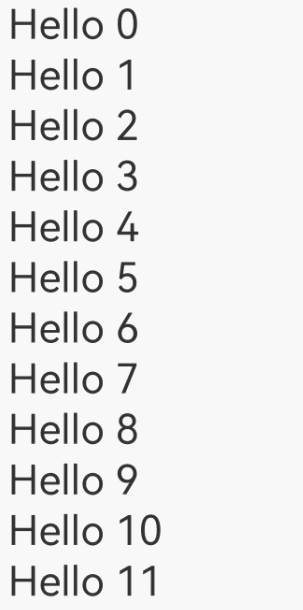
The member variable decorated by @ObjectLink can observe only changes of its sub-properties, not changes of nested properties. Therefore, to instruct a component to re-render, we need to change the component sub-properties. For details, see @Observed and @ObjectLink Decorators.
The following shows the code snippet after optimization:
class BasicDataSource implements IDataSource { private listeners: DataChangeListener[] = []; private originDataArray: StringData[] = []; public totalCount(): number { return 0; } public getData(index: number): StringData { return this.originDataArray[index]; } registerDataChangeListener(listener: DataChangeListener): void { if (this.listeners.indexOf(listener) < 0) { console.info('add listener'); this.listeners.push(listener); } } unregisterDataChangeListener(listener: DataChangeListener): void { const pos = this.listeners.indexOf(listener); if (pos >= 0) { console.info('remove listener'); this.listeners.splice(pos, 1); } } notifyDataReload(): void { this.listeners.forEach(listener => { listener.onDataReloaded(); }) } notifyDataAdd(index: number): void { this.listeners.forEach(listener => { listener.onDataAdd(index); }) } notifyDataChange(index: number): void { this.listeners.forEach(listener => { listener.onDataChange(index); }) } notifyDataDelete(index: number): void { this.listeners.forEach(listener => { listener.onDataDelete(index); }) } } class MyDataSource extends BasicDataSource { private dataArray: StringData[] = []; public totalCount(): number { return this.dataArray.length; } public getData(index: number): StringData { return this.dataArray[index]; } public addData(index: number, data: StringData): void { this.dataArray.splice(index, 0, data); this.notifyDataAdd(index); } public pushData(data: StringData): void { this.dataArray.push(data); this.notifyDataAdd(this.dataArray.length - 1); } } @Observed class StringData { message: NestedString; constructor(message: NestedString) { this.message = message; } } @Observed class NestedString { message: string; constructor(message: string) { this.message = message; } } @Entry @Component struct MyComponent { private moved: number[] = []; @State data: MyDataSource = new MyDataSource(); aboutToAppear() { for (let i = 0; i <= 20; i++) { this.data.pushData(new StringData(new NestedString(`Hello ${i}`))); } } build() { List({ space: 3 }) { LazyForEach(this.data, (item: StringData, index: number) => { ListItem() { ChildComponent({data: item}) } .onClick(() => { item.message = new NestedString(item.message.message + '0'); }) }, (item: StringData, index: number) => item.toString() + index.toString()) }.cachedCount(5) } } @Component struct ChildComponent { @ObjectLink data: StringData build() { Row() { Text(this.data.message.message).fontSize(50) .onAppear(() => { console.info("appear:" + this.data.message.message) }) }.margin({ left: 10, right: 10 }) } }Figure 13 Fixing the UI-not-re-rendered issue
